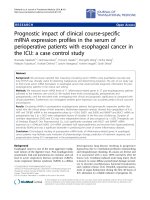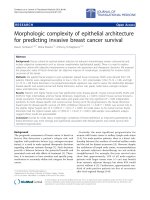Báo cáo hóa học: " A case of a speech impediment following a near lightning strike" ppt
Bạn đang xem bản rút gọn của tài liệu. Xem và tải ngay bản đầy đủ của tài liệu tại đây (106.56 KB, 2 trang )
CAS E RE P O R T Open Access
A case of a speech impediment following a near
lightning strike
Bobby K Desai
*
and Rita Fairclough
Abstract
Environmental electrical injuries (electrical burns and lightning) are relatively common and are estimated to result
in more than 3,000 admissions to specialized burn units each year here in the US. Lightning injuries are a small
subset of electrical injuries and are responsible for an average of 300 injuries and 100 deaths per year in the US.
We present a case of a rare injury obtained as a result of a near lightning strike. The case involved a young female
who was playing soccer when lightning struck within several feet of where she was standing, resulting in loss of
consciousness, paresthesias, tinnitus, muscle spasms and most importantly a new onset of a speech impediment.
There is only one reported case of a speech impediment secondary to an electrical injury in the literature.
Introduction
Lightning injuries are responsible for an average of 300
injuries and 100 deaths per year [1]. Approximately 30
percent of patients that are struck die and up to 73 per-
cent of patients that survive may have permanent disabil-
ities [2]. Deaths can occur within 1 h of injury in the
maj ority of cases, and are second ary to fatal arrhythmias
or respiratory failure. Seventy-four percent of survivors
experience permanent injury and sequelae as indicated by
some reports [3].
More than one half of the fatalities occur while people
are involved in outdoor activities, and another 25 percent
occur during work-related activities.
Between the years of 1980 and 1996 the Centers for
Disease Control reported 1,318 patients killed by light-
ning strikes, of which 85 per cent were male. Within the
United States, the areas with the greatest number of
deaths secondary to lightning were Florida and Texas,
and the states with the highes t incidence of strikes were
New Mexico, Arizona, Arkansas and Mississippi.
Injuries due to electricity occur by three mechanisms:
Direct effect of current on body tissues; conversion of
electrical ene rgy to thermal injury resulting in burns; and
blunt mechanical injury from lightning strike, muscle
contraction or complication of a fall afterwards.
The clinical manifestations of lightning injuries range
from mild burns to severe multiorgan dysfunction and
death. We present a case of a young female who was
knocked unconscious after a near lightning strike and
who sustained subsequent speech impediment, loss of
consciousness, muscle spasms and paresthesias.
Case report
A 28-year-old female presented to the Emergency
Department via EMS at 4 p.m. in the afternoon with the
chief complaint of a near lightning strike. The patient
was outdoors at a field playing Frisbee when lightning
struck a nearby tree that was very close to the patient. As
per witnesses the patient was thrown back with positive
loss of consciousness. When she awoke she complained
of a heavy tongue, speech difficult y, dif ficulty swallowi ng,
tinnitus and diffuse muscle cramps with paresthesias.
The patient had been previously healthy with no past
medical history and was on no current medications.
On examination the patient was normotensive (116/81
mmHg), tachycardic (111 beats per minute) and tachyp-
neic (28 breaths per minute). Physical exam revealed a
well-nourished female, actively crying and upset. The only
abnormal finding on physical exam was her speech. It
appeared and sounded as though she had congenital deaf-
ness. Initial laboratory tests showed total creatine kinase
(CK) of 253 units/L, creatinine of 1.07 mg/dL and remain-
ing laboratory tests within normal limits. The electrocar-
diogram showed a normal sinus rhythm at 82 with normal
intervals and no acute ST abnormality . Computed tomo-
graphy of the head showed no acute injury. The patient
received intravenous fluids and intravenous lorazepam for
* Correspondence:
University of Florida College of Medicine Department of Emergency
Medicine PO Box 100186 Gainesville, FL 32610, USA
Desai and Fairclough International Journal of Emergency Medicine 2011, 4:60
/>© 2011 Desai and Fairclough; licensee Springer. This is an Open Access article distributed under the terms of the Cre ative Commons
Attribution License ( which permits unrestricted use, distribution, and reproduction in
any medium, provided the original work is properly cited.
her muscle spasms. Four hours later repeat laboratory
tests showed a CK total of 506 U/L and a CK-MB of
7.9 U/L, and creatinine of 0.87 mg/dL. Her speech gradu-
ally improved but she continued to complain of severe
muscle spasms of her upper and lower extremities. She
was admitted overnight to the general medicine service for
serial creatine kinase measurements to monitor for rhab-
domyolysis as well as for treatment of her myalgias and
muscle spasms. Freq uent neurological checks would also
be implemented.
In the hospital, the patient was monitored on the tele-
metry floor and no arrhythmias were noted. The total
creatine kinase rose to 614 U/L and her creatinine
returned to normal after 2 L of intravenous fluids. She
continued to have some mu scle spa sms, which improved
with valium. The patient was tolerating oral fluids and
ambulated without difficulty afte r 1 day so she was dis-
charged home to follow-up with her primary care physi-
cian. The pa tient e ventually re turned back to work and
her speech returned to normal. However, she continued to
experience neck and shoulder muscle spasms and mild
short term memory loss. At 1 year follow-up, she voiced
no complaints.
Discussion
Environmental electrical injuries are relatively common,
usua lly accidental and can generally be prevente d. Light-
ning injuries are a small subset of electrical injuries and
are responsible for an average of 300 injuries and 100
deaths per year in the US. Lightning-related fatalities and
hosp italizations are underestimated because much of the
data is taken from newspaper accounts and many survi-
vors do not seek medical attention. Lightning injuries can
be classified as mild, moderate or severe. Mild injuries
consist of loss of cons ciousness , amnesia, confu sion and
tingling. Moderate injuries may consist of seizures, respira-
tory arrest and superficial burns. Severe injuries may con-
sist of cardiopulmonary arrest [3].
We presented a case that appeared t o involve both the
hypoglossal, hypopharyngeal and vagus nerves affecting
normal speech pattern after a near lightning strike. The
effects on t he patient’ s speech were transient in nature.
The remaining effects on the patient’s organ systems only
seemingly involved muscle s pasm, whic h also cleared as
the patient was able to ambulate within 24 h of injury.
The only documented case involving a similar presen-
tation was cited by Baskerkville and McAninch in which
a young female was changing an overhead light bulb in
an 120 volt light fixture, which led to a low voltage
shock and an associated loss of consciousness, and asso-
ciated lingular deviation and slurred speech [4]. This
individual required treatment with carbamazepine and
Botox in order to resolve symptoms over time.
These two cases, although different in current of elec-
tricity, seemingly had similar pathways affected and ulti-
mately had complete resolution of their symptoms. It
appears that in addition to the fatalities associated with
electrical injury, near lightning strikes and low volta ge
electricity can lead to transient peripheral nerve dys-
function. Similarly to the effects on the conduction sys-
tem of the heart, peripheral nerves can be short
circuited, thereby leading to associated dysfunction.
Conclusion
Lightning strikes are primarily a neurologic injury that
affects all three components of the nervous system: per-
ipheral, autonomic and central. Healthcare providers
need to be aware of the injury patterns that can occur
with lightning strikes in order to provide the best possi-
ble care. The pati ent presented in this case transiently
had loss of function of peripheral nerves controlling
tongue movement , but ultimately regained the ability to
produce speech without further sequelae.
Consent
Written informed consent was obtained from the patient
for publication of this case report and any accompany-
ing images. A copy of the written consent is available
for review by the Editor-in-Chief of this journal.
Authors’ contributions
RF completed the initial case report, BD edited, revised the initial report and
added the discussion
Competing interests
The authors declare that they have no competing interests.
Received: 10 June 2011 Accepted: 19 September 2011
Published: 19 September 2011
References
1. Pinto Duane, Clardy Peter: Environmental Injuries., Up to Date. March
26,2008.
2. Bjerke Scott: Lightning Injuries. Emedicine 2009.
3. Baskerville JR, McAninch SA: Focal lingual dystonia, urinary incontinence
and sensory deficits secondary to low voltage electrocution: case report
and literature review. Emergency Medicine Journal 2002, 19:368-371.
4. Cohen JA: Autonomic nervous system disorders and reflex sympathetic
dystrophy in lightning and electrical injuries. Semin Neurol 1995, 15:387.
doi:10.1186/1865-1380-4-60
Cite this article as: Desai and Fairclough: A case of a speech
impediment following a near lightning strike. International Journal of
Emergency Medicine 2011 4:60.
Desai and Fairclough International Journal of Emergency Medicine 2011, 4:60
/>Page 2 of 2









